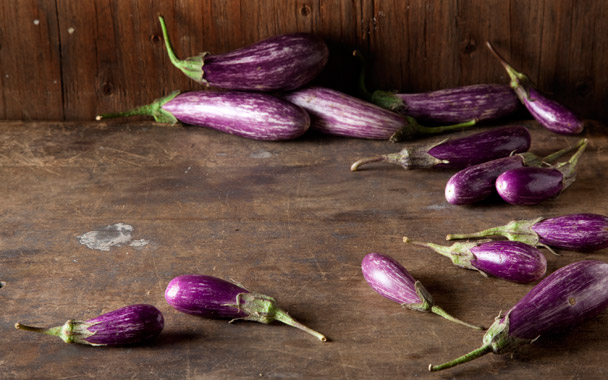Once upon a time there was an eggplant variety named Fairy Tale. It didn’t promise to be the biggest eggplant around, only measuring about four inches long and two inches in diameter, but its slender white body, striped with wild violet, was one of the things I’d pinned my hopes to this summer. Of the vegetables that I’d started from seed (as opposed to buying existing plants from a greenhouse), Fairy Tale was the only one that didn’t croak from my nonscientific methods of nurturing. The plant is a survivor: After spending many weeks under random light bulbs indoors (I had to move the seedlings around whenever I had to actually do something, like, say, cook, in my kitchen), being transplanted into larger pots and placed outdoors, and having one of its number snatched up and gulped down by my landlady’s Italian greyhound, Fairy Tale went into the garden next to its bigger, sturdier eggplant cousins—the bright violet Beatrice, the deeply purple Dusky and Nadia, and the pale beauty Lavender Touch (romantic names, all). Beset by beetles, soil fungus, and torrential downpours, it struggles on, but I’m starry-eyed enough to believe that my Fairy Tale will still have a happy ending. (Drum roll, cymbal crash here, à la Henny Youngman.)
“You can’t grow good eggplant in this clay soil,” said many of our community garden neighbors. Yet Stephen and I persisted, last year and this, and if wishing can make it so, our consistently successful eggplant crop proves it can be done. Frankly, it couldn’t be any other way—I’ve never met an eggplant parmigiana or a creamy eggplant spread I didn’t like. I love eggplant to distraction.
In this I’m distinctly in the minority. Gourmet writer Laura Shapiro, in her homage to ratatouille, says Americans eat less eggplant than they do any other vegetable. Ah, but the Turks and the Iranians, the Thai and the Japanese, the Indians and the Greeks and the Italians… these are eggplant people, and I thank them for it. To the Tibetans I owe a special debt of gratitude, for a ratatouille (registration required) that leans heavily on ginger and garlic.
Gina Marie Miraglia Eriquez, Gourmet food editor and daughter of Italy, is one of the eggplant people. She grows it so that she can marinate it, as her Calabrian aunts do, or serve the slender Asian varieties with a miso glaze. One eggplant does not fit all, and it’s best to grow several varieties. The Thai Green or Roleks, which are pale and a foot long, are perfect for Jungle curry. The Japanese White Egg and Bride varieties are delicate and just right for a shrimp-and-scallop stir-fry. The golden or green-striped Udumalapet is what you want in a baingan bharta. Seedsavers calls the Italian striped Listada de Gandia “the best strain available on the market,” and you might want to use it for eggplant rollatini. And for an eggplant that has an all-around mellow flavor and never needs to be peeled, you can’t beat the Applegreen, the brainchild of the legendary late plant breeder Dr. Elwyn Meader.
Sometimes I work backward, from the name of the eggplant to the dishes I can cook with it. Tomatoes tend to be named cheerily, and potatoes heartily, but for a fairy tale lover, as I am, there’s magic in eggplant varieties called Hansel and Gretel, Ghostbuster and Casper, Tiger (a green-and-white striped Thai) and Goyo Kumba (a shockingly red African variety). Maybe there’s a hint of danger on this side of the nightshade family, too. I can’t imagine inviting a Big Boy to dinner when there’s a Violet Prince or Black King just waiting to make life more interesting.



 Pinterest
Pinterest


